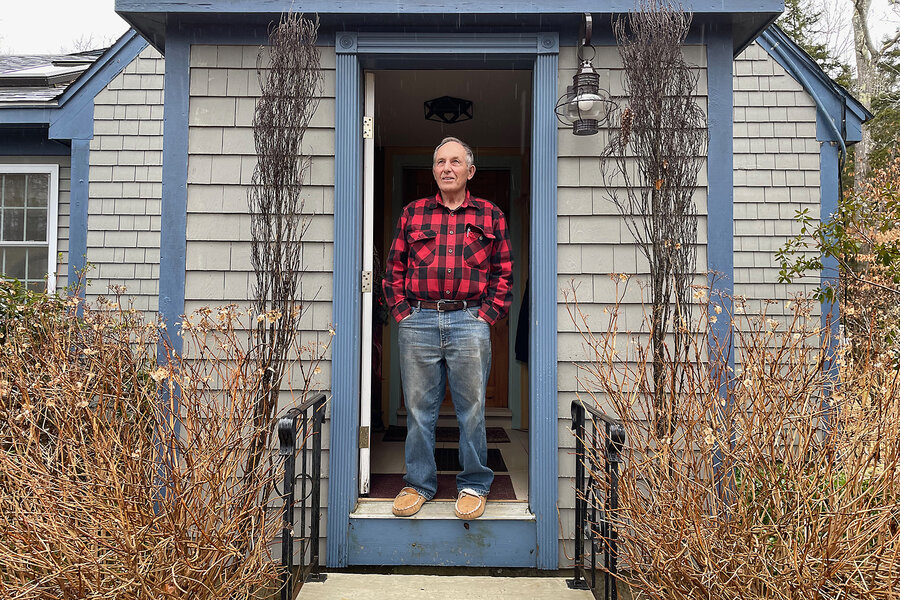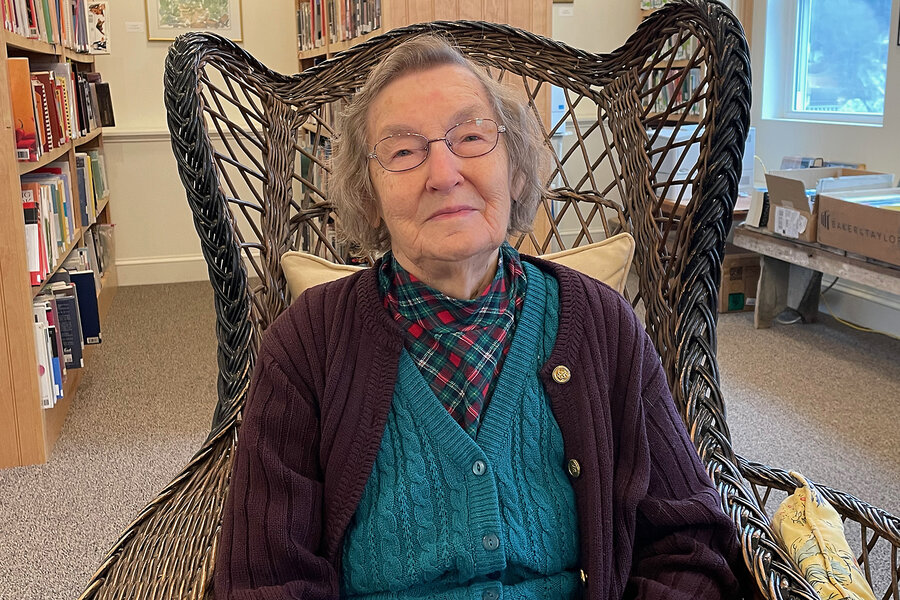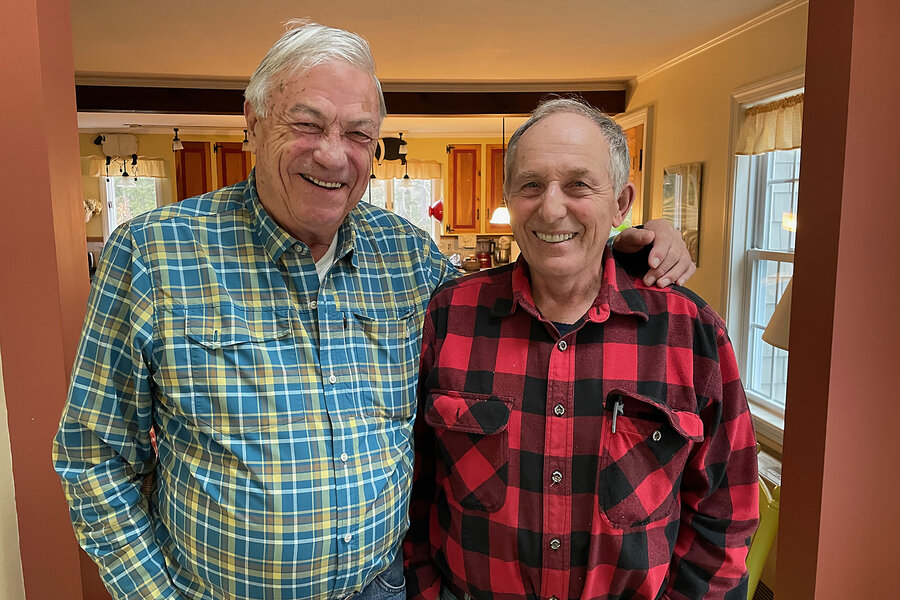The new story of old age in rural America: Neighbors and community lend a hand
Loading...
| Mount Vernon, Maine
The story of old age in rural America has often been a sad one: shrinking populations, a lack of public transport, poor health, and social isolation.
But in Mount Vernon, in Maine – one of the most sparsely populated states in the nation – aging residents are staying put and getting help from friends, neighbors, and community groups. This pattern is repeating itself across the country, say rural aging experts. Many older people want to continue living where they were raised, worked, and brought up families – even if they’re far from stores, hospitals, and sometimes, neighbors.
Why We Wrote This
A story focused onAging in rural areas is often a narrative of limitations – or of being left behind. But a growing share of older rural Americans are choosing to stay because networks of friends, neighbors, and community groups can support them.
“These are real people living real lives,” says Alana Knudson, director of the NORC Walsh Center for Rural Health Analysis. “They walk to the mailbox in the snow. There are some very hardy people aging. And keeping active and busy is really, really important to them.” Older people aren’t “left behind” when younger people move to cities to find work, she says. They choose to stay.
Take Beverly Wight Smith, a Mount Vernon writer and actor, who, at 93, walks less these days but gets rides with family, friends and a volunteer driving service. She just finished a six-week chair yoga course. “There’s so much going on,” she says of her small-town life.
Beverly Wight Smith has seen a lifetime of Maine mud seasons in this former farming town. From growing up on a farm during the Great Depression, to seeing neighbors clop through the mud on horseback during World War II when gasoline was scarce, to watching the trees finally turn green from her porch, this former government worker is happy to have stayed in Mount Vernon.
The farms are few now, the cows and horses that used to fill the fields largely gone. But Ms. Smith says she wouldn’t live anywhere else.
“Everyone is so friendly and helpful,” she says. “People know more neighbors here than they do in the city.”
Why We Wrote This
A story focused onAging in rural areas is often a narrative of limitations – or of being left behind. But a growing share of older rural Americans are choosing to stay because networks of friends, neighbors, and community groups can support them.
The story of old age in rural areas is often portrayed as a sad one: shrinking populations, a lack of public transport, poor health, and social isolation. Here in Maine – one of the most sparsely populated states in America – its aging population is staying put and getting help from friends, neighbors, and community groups. This pattern is repeating itself all over the United States, say experts in rural aging. Many older people want to keep living in the places where they were raised, worked, and brought up their own families – even if they are far from stores, hospitals, and sometimes, their neighbors.
“These are real people living real lives,” says Alana Knudson, director of the NORC Walsh Center for Rural Health Analysis. “They walk to the mailbox in the snow. There are some very hardy people aging. And keeping active and busy is really, really important to them.”
Older people aren’t “left behind” when younger people move to cities to find work, she says. They choose to stay.
Staying is easier for some than for others. Ms. Smith has four children who all live in the state, and a daughter recently moved in with her. Ms. Smith has never driven a car, but it doesn’t matter. If a family member can’t take her where she needs to go, she books a ride with a local volunteer group called Neighbors Driving Neighbors.
Like many people thriving in old age, she keeps busy. She has been writing and acting in local plays for the past 40 years and is the author of a book on a history of the area. Until a few years ago, she could regularly be spotted walking the half-mile or so from her house to the now-shuttered general store, the church, or the community center.
Now 93, she says she walks less these days due to poor balance, but she just finished a six-week course in chair yoga.
“There’s so much going on,” she says of her small town.
A town committee called Aging in Place has a lot to do with that. It’s run mostly by volunteers who are themselves retired, and groups like it are springing up all over Maine, the state with the second-highest percentage of people living in rural areas. Aging in Place organizes events with speakers on various topics, hosts monthly “muffin mornings” at the town’s community center, and checks in on older people who live alone.
A “brave” ask
Alice Olson is in her 70s and is an active member of the committee. She says while committee members do their best to get in touch with those they know are isolated, Mainers, famous for their reserve, must also come to them.
Recently an older man approached her at a coffee morning, announced that he lived alone, and asked that someone on the committee check in with him regularly to make sure he is OK.
“It was brave of him,” she says.
She believes the town would be a good place for older adults even if Aging in Place didn’t exist.
“It’s the community” that keeps her and her husband here, she says. “So many people watch out for each other. I have a friend whose husband died four years ago. Later a tree [in her yard] got hit by a storm, and a neighbor came and cut it down and took the wood away.”
She adds, “It’s just what people do here.”
Sam Alexander lives 65 miles south in Harpswell, on Maine’s rocky coast. A retired contractor, he lives in a house he built in 1973, where he and his second wife raised seven children. He comes from a long line of Maine shipbuilders and farmers. The house sits on land his family has owned since the 1700s.
“My family’s been here so long my ancestors would rise up out of their graves and shoot me dead if I went anywhere,” says Mr. Alexander, age 81. Besides, “I know a lot of people; I have a lot of friends,” including retirees from other states who have made the coast their home.
“I haven’t seen a place I like better,” he says of Harpswell. “This is home. I’m biased, but in lots of respects it’s a great place to live.”
On the couch opposite sits one of his oldest friends, Ralph Black. Unlike Mr. Alexander, Mr. Black, age 80, lives alone on neighboring Orr’s Island. He has a son in the same building, but says family relationships can be tricky. His longtime partner lives in a town 13 miles away. The nearest hospital is around 15 miles away.
“I do worry, living in a rural place ... how will I cope [if I have a serious health problem]? Who’s going to take care of me? Those are concerns that are in my mind,” he says.
Still, the idea of moving to the town of Brunswick, where his partner lives, does not appeal. “I’m not going anywhere,” he insists, citing strong ties to the community where he was born and raised.
Mr. Alexander has children nearby but concedes he hasn’t tapped them for anything much – yet. He still does the haying at the family farm every summer.
“I think most Mainers, if we live in one place a long time, [have] such an independent streak that up until we realize we have to, we don’t want to accept help,” he says. “But [there] comes a point when everybody has to – a little or a lot.”
Send in the Scouts and shop teachers
An independent spirit is something all rural Americans share, says Ashley Washington of Lutheran Services in America. But sometimes it can leave them isolated.
To help older adults in rural areas age successfully at home, Lutheran Services has launched an initiative called the Rural Aging Action Network. It connects isolated older adults with local resources and local people who can make their lives easier.
Currently the network operates in parts of Minnesota, Montana, and North and South Dakota.
In these states, “you may see the nearest health care facility up to 200 miles away,” says Ms. Washington.
She describes their outreach efforts, which began last year, as working well. In a town in Montana, an older woman who could no longer take care of her lawn received help from a troop of Boy Scouts who took on the job. In a tiny town in South Dakota, she says, some seniors couldn’t afford to update their homes with accessories like wheelchair ramps. A local high school wood shop teacher volunteered his help.
Ms. Washington says the gratitude goes both ways.
“A lot of these [local people] are so encouraged by the invitation to help their neighbors,” she says, and are delighted to step in. “That’s really something that we see is unique in rural communities.”










